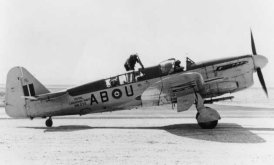
Fairey Firefly
Among the Firefly's features that made it such an advance over the Fulmar were its more powerful Rolls-Royce Griffon engine, 20 mm (0.79 in) Cannon armament, a higher top speed and a set of Fairey-Youngman flaps. The latter greatly improved low speed handling and all round manoeuvrability.
The Firefly prototype flew on 22 December 1941 and the following year 200 Firefly F.Mk Is were ordered for the Fleet Air Arm (FAA). Between 1943 and 1946 850 Mk Is were built, including a batch by General Aircraft.
Following the F.Mk I into service was the FR.Mk I fighter reconnaissance version, with American ASH air to surface vessel radar fitted. (F.Mk Is converted to FR standard were known as F.Mk IAs.) The only Firefly Mk IIs built were 37 NF.Mk II night fighters, with AI.Mk X radar. When it was decided to convert FR.Mk Is for the role (as NF.Mk Is with modified ASH radar), further Mk II production was cancelled.
The Mk I was operational for the first time in July 1944, when aircraft from No.1770 Squadron aboard HMS Indefatigable attacked gun positions and auxiliary vessels during raids on the German battleship Tirpitz. In the Far East, FAA Fireflies attacked Japanese oil refineries on Sumatra in January 1945. After joining the British Pacific Fleet, three Firefly squadrons took part in raids on the Caroline Islands during June.
Fighter reconnaissance aircraft had been part of the Royal Navy's inventory since the mid-1920s, when machines like the Fleeting and Osprey were conceived. The first monoplane in this class was the Fairey Fulmar of 1940 and it was to replace this aircraft that another Fairey product, the Firefly, was designed. Perhaps better known for its post-war service, the Firely served from 1943 and was active on raids against the Tirpitz and in the Pacific.
 |
 |
 |
| Like other carrier-borne aircraft the Firefly had folding wings to facilitate storage aboard ship. These were heavy and had to be manhandled into position by deck crews before each flight. |
A Firefly sets off in search of Japanese surface vessels during the closing stages of World War II. |
Equipped with a bulky AI.Mk X radar, the NF.Mk II Firefly featured an extended forward fuselage to retain the same centre of gravity for the aircraft. |
|
Fairey Firefly (Technical Specification) |
| Role |
Two seat reconnaissance fighter and fighter/bomber |
| Manufacturer |
Fairey |
| Maximum Speed |
509 kmh (316 mph) |
| Maximum Range |
2,092 km (1,300 miles) |
| Ceiling |
8,535 meters (28,000 feet) |
Weight
Empty
Maximum Takeoff |
4,423 kg (9,731 lbs)
6,359 kg (13,990 lbs) |
Dimensions
Wingspan
Length
Height
Wing Area |
13.56 meters (44 ft, 6 in)
11.46 meters (37 ft, 7 in)
4.14 meters (13 ft, 7 in)
30.47 square meters (326 sq ft) |
| Engines |
One Rolls Royce Griffon IIB piston engine which provides 1,290-kW (1,730 hp) |
| Armament |
Four 20 mm (0.79 in) Hispano cannon in wings
Eight 27 kg (60 lb) rockets or
Two 454 kg (1,000 lb) bombs on wing racks |
Photo Gallery
Click here to submit your photo
| Have A Passion For Aircraft? |
Subscribe to our 14 series FREE newsletter
delivered weekly on World War 2 Aircraft factfile... |
| NB:- We hate spam as much as you do, so your email address will NEVER be shared with or sold to anyone else. That's a Guarantee. |
|
|





